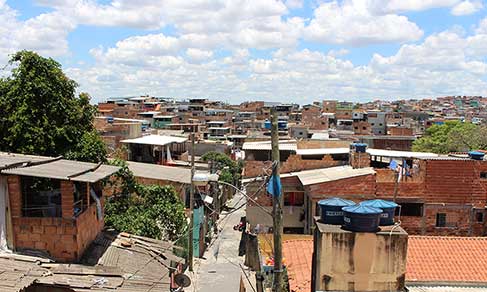Continuous PNAD
Unprecedented IBGE survey shows that 7.4 million people teleworked in 2022
October 25, 2023 10h00 AM | Last Updated: November 03, 2023 04h39 PM
Highlights
- In 2022, nearly 7.4 million people teleworked, a sub-group of remote working. This means that these workers were working, at least partially, in an alternative place and used information and communication technology (ICT) equipment in their activities.
- In the same period, 9.5 million people worked remotely in Brazil, which includes those not using ICT equipment, as well as the teleworkers. This contingent represents 9.8% of the total number of employed persons who were not away from work (96.7 million).
- The proportion of employed women who teleworked (8.7%) was higher than that of men (6.8%).
- When considering color or race, it is possible to conclude that white persons (11.0%) also registered higher percentages than black (5.2%) and brown (4.8%) employed persons.
- Nearly one quarter (25.8%) of the persons employed in the sector of information, communication and financial, real estate, professional and administrative activities teleworked at least one day in the reference period of the survey.
- Average earnings of teleworkers were also higher (R$6,479) than those of the non-teleworkers (R$2,398).
- Nearly half (49.6%) of the households of the total number of employed persons had computers and Internet. That proportion was 91.2% among teleworkers.

In 2022, 7.4 million persons teleworked in Brazil, either usually or occasionally. It represents 7.7% of the total number of employed persons who were not away from work (96.7 million). The data are from the unprecedented Teleworking and Work through Digital Platforms module of the Continuous National Household Sample Survey (Continuous PNAD), released today (25) by the IBGE. The study is the result of a technical cooperation agreement with the State University of Campinas (Unicamp) and the Public Prosecutor´s Office of Labor (MPT). The statistics released in the publication are experimental, i.e., they are in the test phase and under assessment.
According to a classification from the International Labor Organization (ILO) used in the survey, teleworking is a type of remote work. In this modality, work is done in an alternative place, which might be the household itself or another place, using information and communication technology (ICT) equipment, like computers, telephones and tablets to accomplish the work tasks.
The publication estimated at 9.5 million the number of persons who worked remotely in the reference period, which represented 9.8% of the total number of employed persons who were not away from work. These data point out 2.1 million persons working remotely in 2022, though not teleworking as they were not using ICT equipment to accomplish their work tasks.
“A remote work requires that the work is accomplished in an environment different from the standard workplace, i.e., in a place different from that in which it is typically carried out, considering both the job exerted by the person and its employment type. Let´s suppose that a self-employed person works at home in the production of bread and cakes for sale. As the household itself is the place where the business is carried out, working at home is not considered a remote work for this person. Teleworking is a sub-category of remote work, occurring whenever ICT equipment is used to carry out work tasks,” explains Gustavo Fontes, an analyst of the survey.
The researcher states that the social distancing imposed by the Covid-19 pandemic leveraged teleworking, which remains in use by companies. “Even with the retraction of the pandemic with the end of the health emergency situation, we perceived that many people remain working in this condition, at least partially,” points him.
The analysis of the data by sex, color or race, age group and other divisions allows to establish the characteristics of the persons who were teleworking in 2022. Nearly 8.7% of the employed women worked in this modality against 6.8% of men. White persons (11.0%) also recorded percentages quite higher than black (5.2%) and brown (4.8%) persons. The age group with the lowest proportion of workers in this situation was that of teenagers (14 to 17 years), with 1.2%. On the other hand, the highest percentage was the group aged between 25 and 39 years (9.7%), above the national average.
The survey investigated teleworking by schooling level as well. Only 0.6% of those employed without complete primary education worked remotely using ICT equipment. Among those with complete primary education or incomplete secondary education, that percentage rose to 1.3%. The highest proportion was among those with complete higher education: 23.5% worked this way at least occasionally.
“Of all the teleworkers, nearly 70% had higher education. The proportion was also much higher among science professionals and scholars, a group that includes, for instance, engineers, lawyers, economists, teachers and several IT professionals, as well as managers and directors. These types of jobs tend to be favorable to teleworking,” explains the analyst.
In the analysis by employment type, the groups highlighted by Fontes were those with the highest percentage of teleworkers. More than one quarter (28.6%) of science professionals and scholars teleworked. It was followed by the group of directors and managers (26.1%), with positions related to management, board of directors or management of work teams.

When considering the universe of employed teleworkers, most of them were men (51.2%), whereas 48.8% were women. Nearly half of the teleworkers (49.6%) were aged between 25 and 39 years and 35.4%, between 40 and 59 years. Altogether, these brackets accounted for 85.0% of the total. Most of the employed persons working remotely with ICT equipment were white persons (63.3%). The proportion of black and brown persons was quite lower: 7.7% and 27.1%, respectively.
“These data might be related to the insertion in the labor market, as well as to the schooling level. We know that managerial positions and jobs of scientific or intellectual nature were predominantly occupied by white persons. It might explain the difference of these rates. It is a reflection of inequality in the access to higher education, as well as to the best paid jobs in Brazil,” analyzes Fontes.
Employers had higher proportion of teleworking professionals
Nearly 16.6% of the employers were teleworking at least partially in 2022. It was the professional category that mostly prevailed among those who worked in this modality in the reference period. It was followed by those employed in in the public sector (11.6%) and those employed in the private sector with a formal contract (8.2%).
The groups with the lower proportions of teleworkers were those employed in the private sector without a formal contract (7.5%), self-employed workers (5.7%) and assisting family workers (2.1%). Domestic workers registered a nearly null percentage, since the number of persons was low due to both the methodology of the sampling survey and the nature of the job, little compatible with teleworking.
“Adherence to teleworking is more difficult in jobs aimed at attending the public, involving manual work and machine operation,” says the researcher.
“In the case of jobs with a low correlation to teleworking, like the elementary ones including domestic workers, street cleaners and several manual workers in civil construction and agriculture, physical presence is usually required. Teleworking also requires the use of ICT equipment to carry out the tasks and, in these jobs, this equipment is not usually required to accomplish the work,” completes him.
One out of four persons (25.8%) employed in the sector of information, communication and financial, real estate, professional and administrative activities teleworked last year. The publication highlights that it is a whole set of activities that favor this type of work, like information technology, legal and accounting services.
On the other hand, the groups of activity less compatible with teleworking had, thus, less professionals working this way: Domestic services (0.0%), Agriculture, livestock, forestry, fishery and aquaculture (0.4%), Construction (2.5%), Lodging and food (2.8%) and Transportation, storage and mailing (2.8%).
Average earnings of teleworkers were two times higher
The average earnings of the employed population in Brazil were of R$2,714 in 2022, though they were 2.4 times higher for those who carried out at least one day of teleworking in the reference period: R$6,479. Earnings were below the average for those who did not work this way: R$2,398.
The analyst of the survey highlights that this difference is not exclusively due to the use of teleworking. “It is a correlation with the type of job that favors that work modality, which tends to pay higher salaries. For example, it is the case of those jobs with higher proportions of workers using teleworking, like managers and science professionals and scholars,” explains Fontes.
The average earnings of those teleworkers were higher in the Central-West (R$7,255), whereas the Northeast recorded the lowest one: R$4,820. The average earnings of teleworkers were higher than those non-teleworkers in all the regions.
The survey also investigated the theme in relation to hours worked. In this indicator, the difference was small between teleworkers and non-teleworkers. The average work hours per week was slightly higher among teleworkers: 39.7 hours against 39.3 for non-teleworkers. The average hours worked for the total number of employed persons in Brazil was 39.3 as well.
Nearly 8.7 million worked remotely in their own households
Besides teleworking carried out in any environment (their own homes, other households or other spaces - always as an alternative place to the office), the survey also brought data of when their function was exerted in the worker´s own household. Nearly 15.6% of the total number of employed persons, who were not away from work, worked in their own households in 2022. Those who carry out remote working added up to 8.7 million, which represented 9.0% of the total number of employed persons. As a division within this type of work, teleworking registered a lower percentage: 7.3% of the employed persons or 7 million people. This means that 94.8% of the employed persons who teleworked did that in their own houses.
As the access to the Internet is key to teleworking, these data were assessed by the researchers as well. Nearly half (49.6%) of the households of the total number of employed persons had computers and Internet. That proportion rises to 91.2% when considering teleworkers only. Less than 9% of them did not have any computer, though they accessed the Internet at home. Nearly all teleworkers (99.8%) had access to the Internet in their own households.
More about the survey
The unprecedented Teleworking and Work through digital platforms module of the Continuous National Household Sample Survey (Continuous PNAD) analyzes these new forms of work in Brazil in 2022. The data are analyzed by color or race, sex, age group, schooling level and employment type among other divisions. For more information, please access the complete publication and the support material.




















